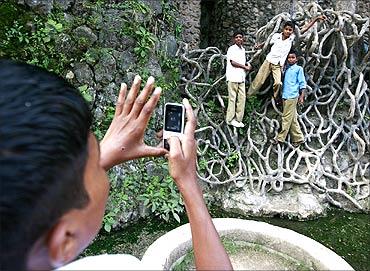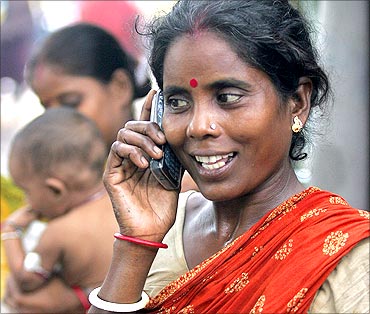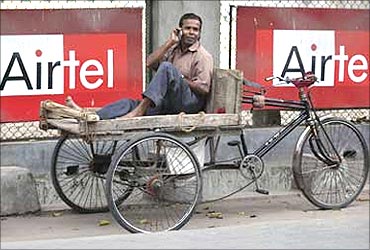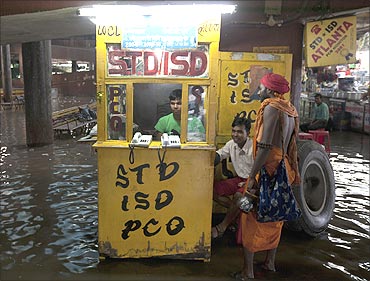Photographs: Andrew Caballero/Reuters. Indicus Analytics
The rise in the number of mobile or wireless subscribers has been accompanied by a decline in landline or wireline connections, since people are giving up what once used to be a much sought-after phone connection.
Tele-density in the wireline and wireless segments was at similar levels of about 4 per cent coverage each in 2005; according to latest estimates for August 2010 while wireline tele-density is 3.02 per cent, wireless tele-density stands at 56.61 per cent.
...
How India can ring in a telecom revolution
Image: Prem (3), the son of an idol vendor, plays with a mobile phonePhotographs: Ajay Verma/Reuters.
This makes comparison across states problematic, especially when we see a near-200 per cent tele-density in Delhi-NCR service area and then compare it to the lowest figure of around 32 per cent in Assam, Bihar and Jharkhand.
How India can ring in a telecom revolution
Image: Tulsi Prasad, an Indian slum dweller, uses a mobile phone.Rural tele-density is highest in Himachal Pradesh, Kerala, Punjab and Haryana, while Madhya Pradesh and Bihar service areas, which include Chhattisgarh and Jharkhand, have the lowest rural tele-density rates of less than 20 per cent.
...
How India can ring in a telecom revolution
Image: Common Service Centre run by the govt.Photographs: Courtesy, CSC.
Internet penetration is another measure of connectivity. The number of internet users is estimated at 81 million, according to International Telecommunications Union data; and the Telecom Regulatory Authority of India sets the number of broadband subscribers at 10.08 million in August 2010.
How India can ring in a telecom revolution
Image: Rise in mobile phone susbcribers.Photographs: Reuters.
The scheme is close to its target of covering all villages by March 2011; as of August 2010, 20 states have a more than 70 per cent rollout, three states have crossed the halfway mark and the remainder have more than half their target to cover.
How India can ring in a telecom revolution
Image: People sit in a flooded phone booth at a bus station after heavy rains in New Delhi.Photographs: Enrico Fabian/Reuters.
![]()
Indian States Development Scorecard is a weekly feature by Indicus Analytics that focuses on the progress in India and the states across various socio-economic parameters.








article